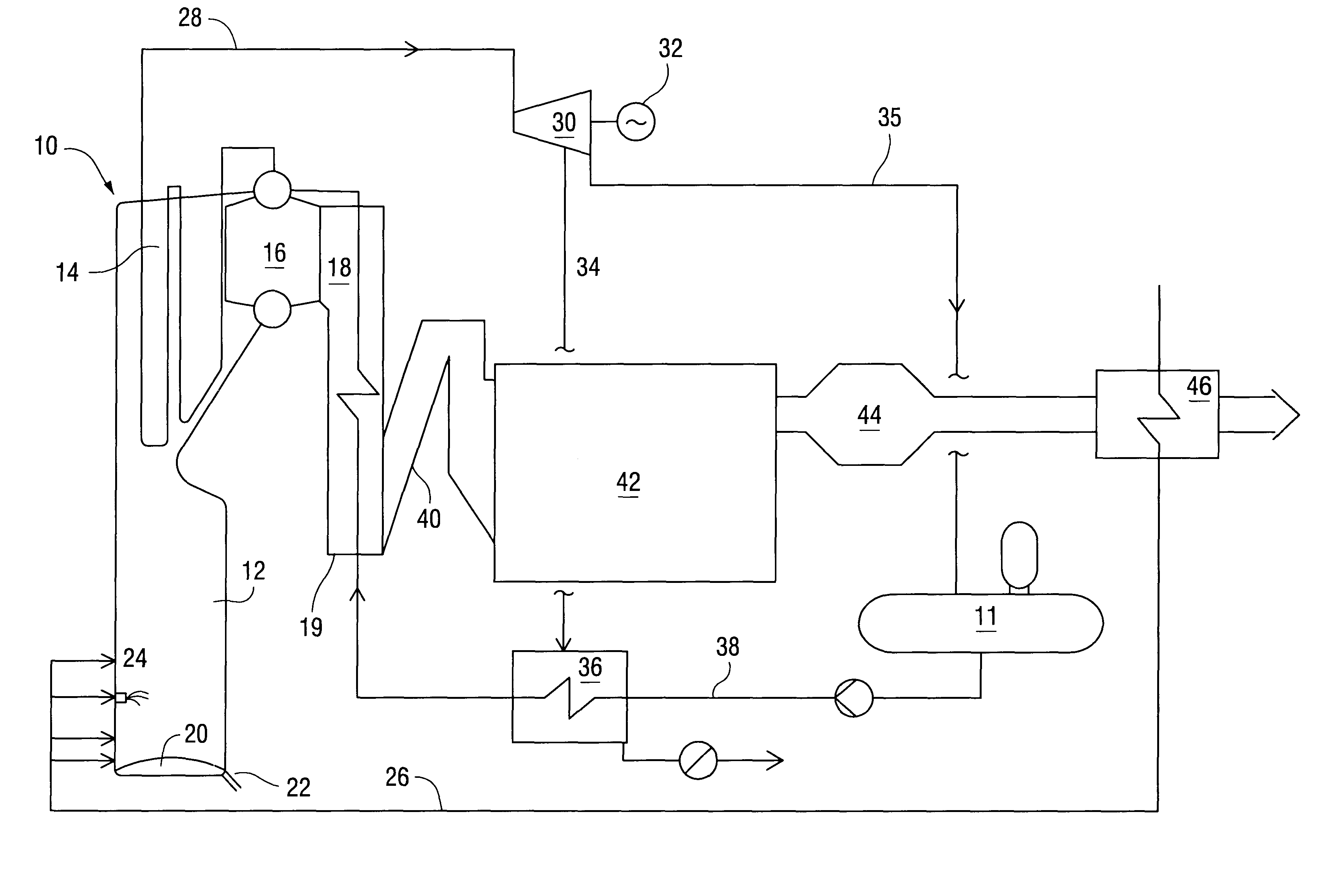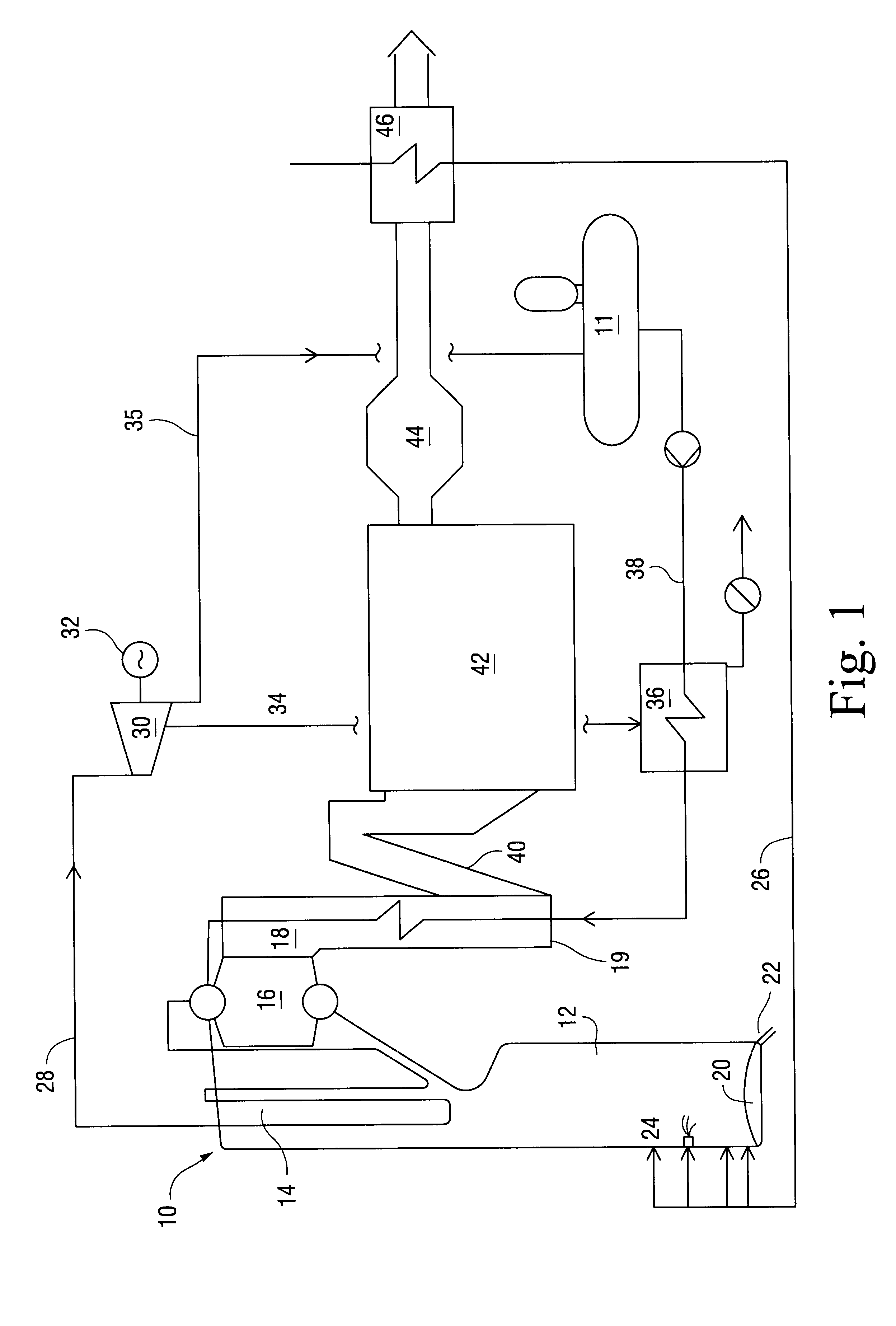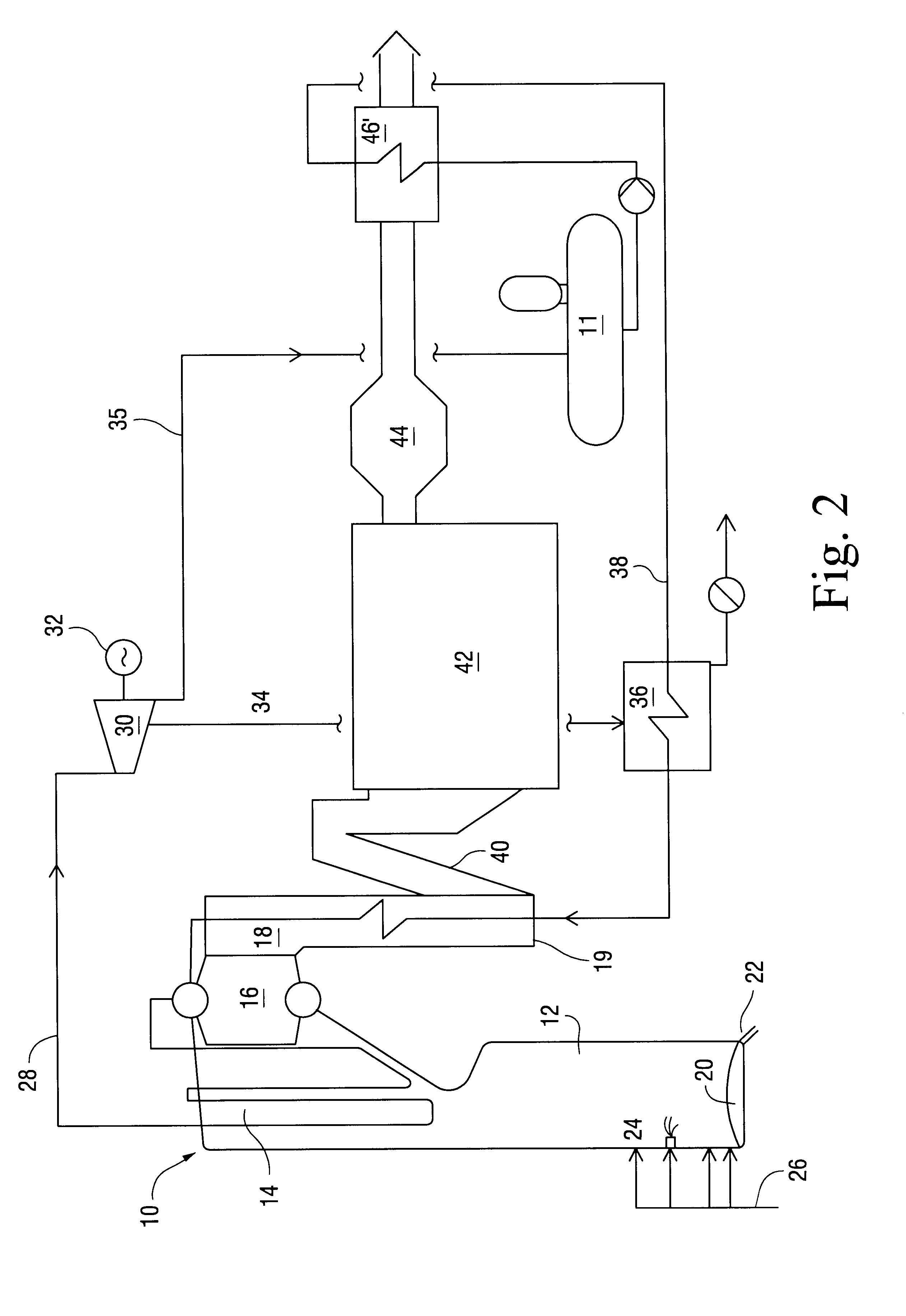In steam boiler plants, the higher the
steam pressure and temperature in the boiler may be raised and the lower the pressure of the steam taken from the
turbine to be used for the needs of the mill, the higher the overall
electrical efficiency of the
plant is, i.e., the ratio between the net production of
electric power and the consumption of process heat. There is a need to raise the overall
electrical efficiency of the recovery boilers nearer to that of the conventional
coal-fired power plants, i.e., the pressure and the temperature of the steam produced by the recovery boilers should be raised to as high a level as possible. In other industrial boilers, the conventional
steam pressure / temperature is, e.g., 130 bar / 540.degree. C. In primary power plants producing only electricity, the pressure and the temperatures of the steam are even distinctly higher than that, and also intermediate
superheating is practiced in them. In recovery boilers, the typical pressure of fresh steam has been 60-90 bar, but nowadays, due to many improvements of apparatuses and processes as well as better materials, significantly higher pressures and temperatures, even e.g., 120 bar and 520.degree. C., may be achieved.
EP patent 724683 presents an installation of a steam boiler provided with a furnace and a
steam turbine, in which the preheating of the feed water for the boiler by means of bleeding steam of the steam turbine has been effected by locating the preheater between two economizers. By this installation, the
overall efficiency of electricity production can be increased compared to a situation devoid of preheating. Prior art knows also the method presented in DE patent 2 243 380 to divide the feed
water flow to a
branch going into the boiler (the economizer) and a
branch going to the high-pressure preheating. This arrangement also increases the overall
electrical efficiency, but less than the arrangement described in EP patent 724683.
An objective of the present invention is to improve the yield i.e. the overall electrical efficiency of the recovery boiler and the steam turbine
assembly. The present invention, in one embodiment, is a method in which bled steam of a steam turbine may be used for preheating the feed water of the boiler without disadvantageously affecting said overall electrical efficiency. A further objective of the invention is to improve said overall electrical efficiency so that the flue gases may be cleaned as efficiently as possible to remove impurities contained therein, but simultaneously recovering the
thermal energy thereof as efficiently as possible.
According to an embodiment of the invention, the dry solids content of the
black liquor to be combusted is raised to a value of more than 80 weight per cent, typically 80-95 weight per cent, preferably 85-90 weight per cent and the combustion is effected by operating with a small amount of excess air. Thus, the flue gas flow of the recovery boiler and the
heat capacity flow of the flue gas are reduced, as the
water content of the flue gas is lower compared to the case of combusting weaker black liquor. FI
patent application 974345 presents a preferred method of evaporating black liquor to a high dry solids content and feeding it into the recovery boiler.
A further feature of the invention is that the feed water for the boiler is preheated by means of bled steam of the steam turbine so that the flue gases leave the economizer at a temperature of more than 250.degree. C., preferably at a temperature of 300-350.degree. C. This temperature is essentially higher than the temperature of about 150.degree. C., at which temperature the flue gases are discharged from the economizer to the flue gas cleaning
system, as known. Thus, the efficiency of the steam turbine process is increased, as the
back pressure steams and bled steams may be efficiently used for preheating the feed water. The high
discharge temperature of the flue gases is made possible by locating the hot
electrostatic precipitator after the economizer in the flue gas line. The hot
electrostatic precipitator, in which ash particles are removed from the flue gas, operates at a temperature of more than 250.degree. C., preferably at 300-350.degree. C. Due to such a high temperature of the flue gas, a so-called SCR-process for removing
nitrogen oxides may preferably be installed after the hot electrostatic precipitator. Due to constantly tightening environmental regulations,
nitrogen oxides have to be efficiently removed from the flue gases of the recovery boiler, down to a level of 10-20 ppm. Typical allowed amounts of
nitrogen oxide effluent are at the present 60-120 ppm. Earlier, economical use of the SCR-method was not possible due to the low temperature of the flue gas, which had been discharged from the recovery boiler and cleaned of particulate matter. The use of the SCR-process in connection with the invention is not necessary, if the removal of
nitrogen oxides may be effected by some other method.
One
advantage of the invention is to effect in a recovery boiler combusting waste liquid in a
pulp mill an implementation in which the feed water may be heated to a relatively high temperature by means of bled steam flows of the turbine and thus increase the efficiency of electricity production (or, more exactly, the amount of electricity produced in relation to the amount of process steams, i.e., the overall electrical efficiency in
back pressure production). The low-level temperature of the flue gases is then recovered into combustion air or boiler feed water. In recovery boilers, the preheating of combustion air with flue gases has been prevented by the
fouling properties of the flue gases clogging conventional flue gas / air preheaters. In this invention, this problem is avoided by using a hot electrostatic precipitator, with the help of which also reduction of
nitrogen oxides in the flue gases of the recovery boiler may be effected, which nowadays is also current, as so far there is no SCR catalyst available operating reliably, if the flue gases of the recovery boiler have not been cleaned of
fly ash. A known solution for the operation of a SCR-catalyst, when the flue gases are
fouling, is to locate a purifying apparatus for
nitrogen oxides operating on an SCR-basis after a cold (120-200.degree. C.) electrostatic precipitator so that the temperature is raised to the
operating temperature of the catalyst, which is in this case about 260-330.degree. C., by means of a regenerator and additional combustion. A
disadvantage of this solution is thermal loss, which has to be compensated by fuel combustion. The lost
temperature difference in the flue gases is typically 20-50.degree. C. And further, the apparatus is expensive.
 Login to View More
Login to View More 


